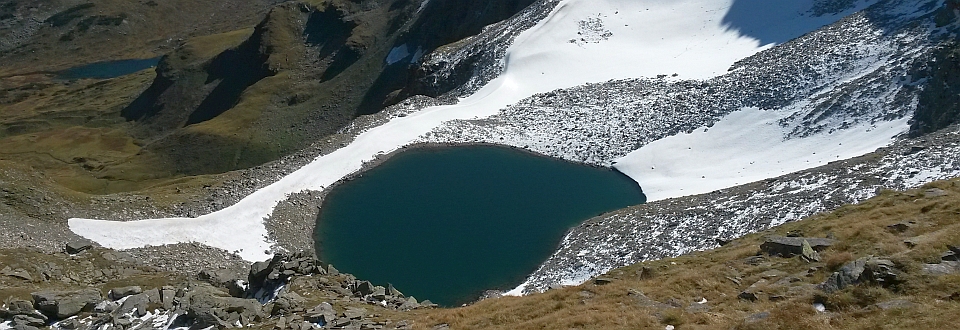PROJECT FutureLakes
Formation and Future Evolution of Glacier Lakes in Austria
Glacier retreat is one of the most visible consequences of temperature rise in the 20th and 21st century in the European Alps. Models suggest that a mean temperature rise by 3°C will lead to a decrease to less than 20% of today's glacier area in Austria within the next century. Glacier retreat can result in the formation of glacial lakes, as already observed at various glaciers in Austria and in other mountain areas in the world. A preliminary study simulated a total of 165 potential subglacial depressions underneath today's glaciers in Austria representing a total potential lake volume of 236 Mio m³ emerging after the melting of glaciers.
Glacial lakes can constitute important environmental and socio-economic impacts on high mountain systems including water resource management, sediment delivery, natural hazards, energy production, and tourism. Their development will significantly modify the landscape configuration and visual appearance of high mountain areas. Also, touristic aspects related to lake formation can be identified as newly formed lakes provide attractive new alpine destinations, potentially able to compensate for the aesthetic loss of glaciers in landscape perception. However, quantitative information on these significant future changes of the high alpine landscape in Austria is largely missing. We propose to apply an interdisciplinary approach to close this research gap.
The project will target three objectives: (i) detect potential overdeepenings underneath Austrian glaciers and relate them to lake formation; (ii) cross-validate different methods to simulate glacier bed overdeepenings; and (iii) analyze geomorphological conditions of lake formation and lake evolution.
To reach these aims, researchers from six institutions working in the field of glaciology, geomorphology, and hydrology, from both Austria and Switzerland, will collaborate. The team strives to deliver a data base of potential lake locations and characteristics as well as insight into lake formation and lake evolution, providing valuable base knowledge for natural hazard and risk assessment, hydrological management and socio-economic impact analysis.
PROFILE
Contribution GEORESEARCH: Project Co-Lead
Projekt Partners: University of Salzburg, Institute for Interdisciplinary Mountain Research (IGF), Central Institute for Meteorology and Geodynamics (ZAMG), ZHAW (Zurich, CH), University of Fribourg (Fribourg, CH), alpS GmbH, Hydrographic Service Salzburg
Projekt Duration: 2015 - 2017
Funding: Austrian Academy of Sciences (ESS 2013)
Project Homepage:
http://www.geomorphology.at/futurelakes.html
TV Documentary: Georadar Measurements at the Obersulzbachsee

A crew filming for the TV documentary "Gletscherschmelze - Klimawandel im Hochgebirge" followed us for one day during geradar measurements at the Obersulzbachsee.
more details ...
PROJECT PARTNERS
Institute for Interdisciplinary Mountain Research
Central Institute for Meteorology and Geodynamics
alpS - Centre for Climate Change Adaptation
Zurich University of Applied Sciences
SELECTED REFERENCES
2021:
Otto J.-C., Helfricht K., Prasicek G., Binder D., Keuschnig M. (2021): Testing the performance of ice thickness models to estimate the formation of potential future glacial lakes in Austria. Earth Surface Processes and Landforms, https://doi.org/10.1002/esp.5266.
2018:
Buckel J., Otto J.-C., Prasicek G., Keuschnig M. (2018): Glacial lakes in Austria - Distribution and formation since the Little Ice Age. Global and Planetary Change, Vol. 164, 39-51.
2017:
Otto J.-C., Helfricht K., Prasicek G., Buckel J., Keuschnig M. (2017): Predicting future glacial lakes in Austria using different modelling approaches. Poster presentation at the EGU General Assembly 2017, Geophysical Research Abstracts Vol. 19, EGU2017-14016, 2017.
Buckel J., Otto J.-C., Keuschnig M. (2017): The formation of glacial lakes in Austria since the Little Ice Age. Talk at the EGU General Assembly 2017, Geophysical Research Abstracts Vol. 19, EGU2017-13397.
Prasicek G., Otto J.-C., Buckel J., Keuschnig M. (2017): Hypsometry and the distribution of high-alpine lakes in the European Alps. Poster presentation at the EGU General Assembly 2017, Geophysical Research Abstracts Vol. 19, EGU2017-13237.
2016:
Otto J.-C., Etzlsdorfer J., Buckel J., Keuschnig M., Griesebner G., Kum G., Wiesenegger H. (2016): What goes in comes out, does it? Proglacial lake sedimentation patterns and trapping efficiency derived from ground penetrating radar and echo sounding. Posterpräsentation auf der EGU General Assembly 2016, 17.-22. April 2016, Wien.
Helfricht K., Huss M., Otto J.-C. (2016): Ice thickness estimations based on multi-temporal glacier inventories – potential and challenges. Posterpräsentation auf der EGU General Assembly 2016, 17.-22. April 2016, Wien.
Buckel J., Otto J.-C., Götz J., Keuschnig M. (2016): An inventory of high-alpine lakes in Austria - FutureLakes. Posterpräsentation auf der EGU General Assembly 2016, 17.-22. April 2016, Wien.
Planet Wissen: Gletscherschmelze - Klimawandel im Hochgebirge. TV-Dokumentation auf ARD Alpha und Bayerischer Rundfunk (21.10.2016).
Obersulzbachsee - Der See unter dem Gletscher. TV-Dokumentation auf ARD Alpha und Bayerischer Rundfunk (02.08.2016).
Tauzeit in Österreichs Bergen: Seen lösen Gletscher ab. Salzburger Nachrichten (08.04.2016).
Im Land der neuen Seen. Die Presse (26.03.2016)
2015:
Fischer A., Span N., Kuhn M., Helfricht K., Stocker-Waldhuber M., Seiser B., Massimo M., Butschek M. (2015): Ground-penetrating radar (GPR) point measurements of ice thickness in Austria. Institute for Interdisciplinary Mountain Research of the Austrian Academy of Sciences, doi:10.1594/PANGAEA.849497.
Buckel J., Otto J.-C., Helfricht K., Binder D., Geilhausen M., Keuschnig M. (2015): Formation and future evolution of glacier lakes in Austria – Research agenda and first results of the FutureLakes project. Posterpräsentation auf der internationalen Konferenz Perth III: Mountains of Our Future Earth, 4.-8. Oktober 2015, Perth, Großbritannien.



